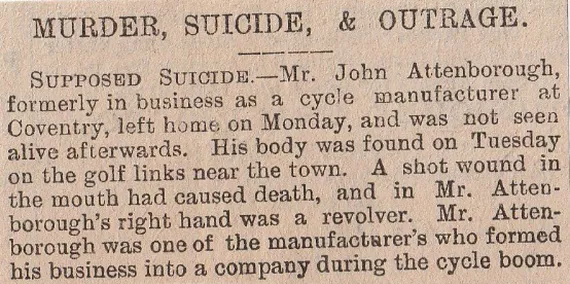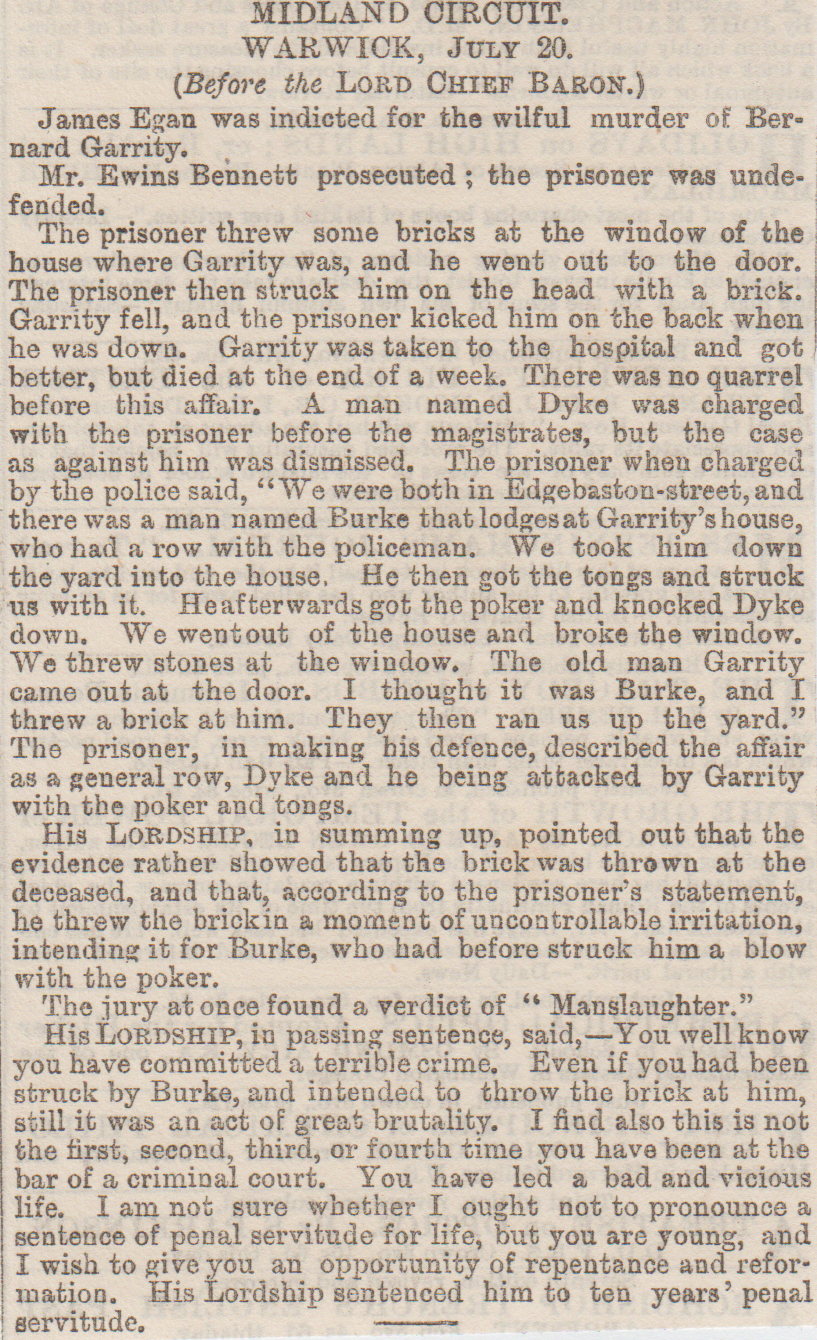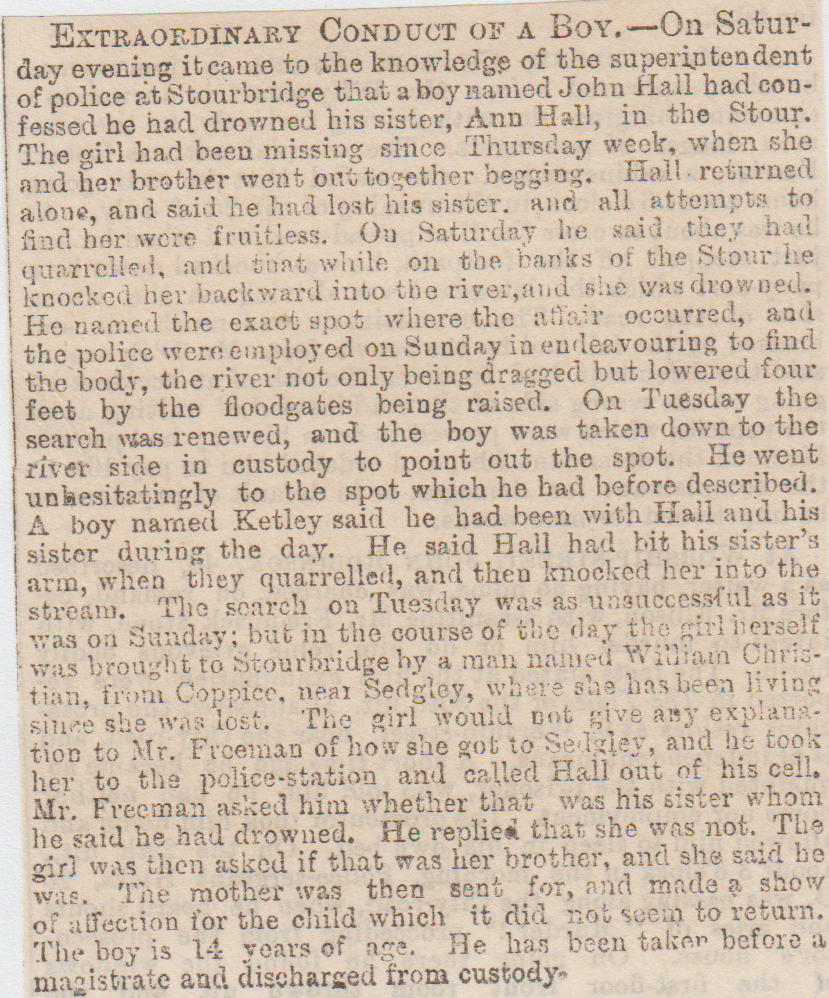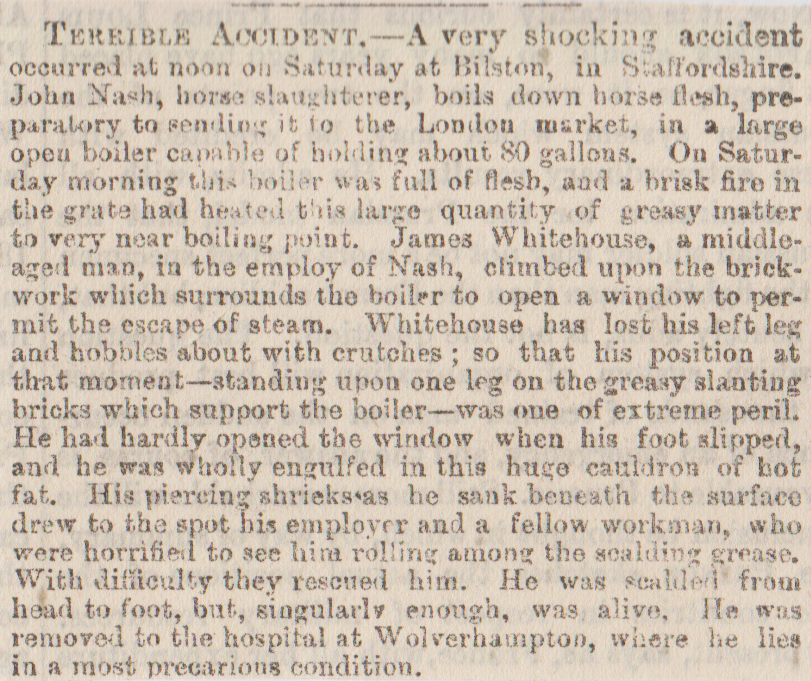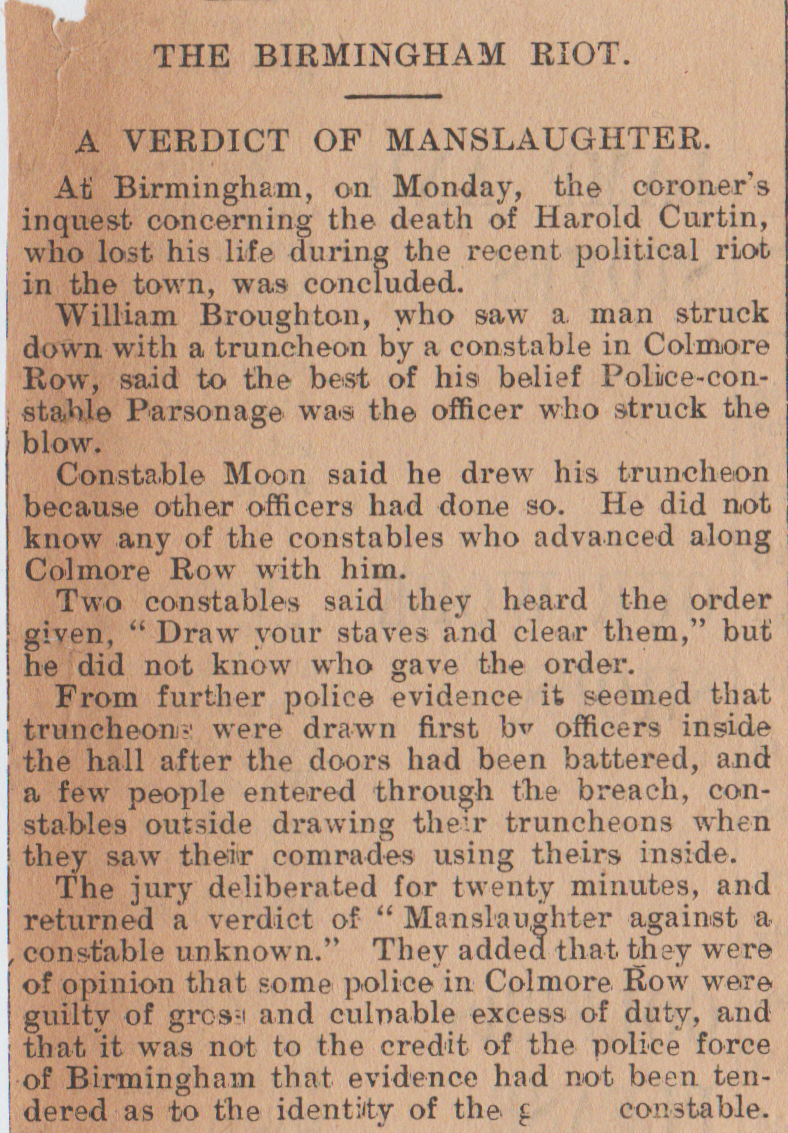1/ West Bromwich Murder, April 1859
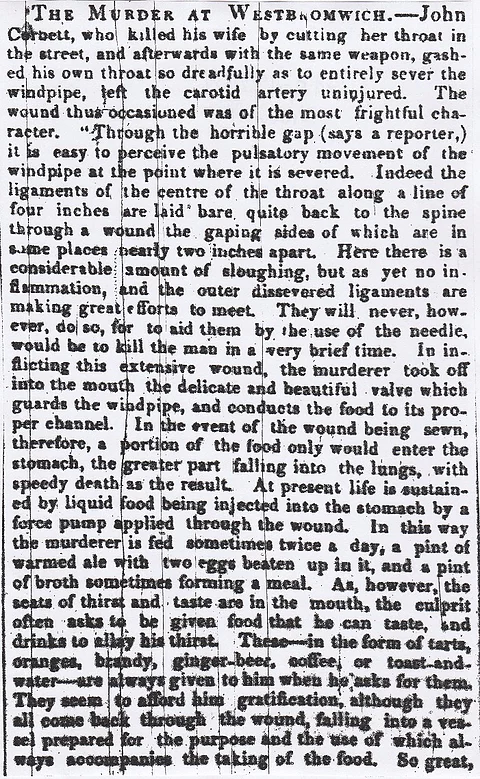
2/ Aston, Birmingham, January 1884 (Body in Room For Twenty Years)
William Owen was a Japanner, who was living hand to mouth in Aston, now a suburb of Birmingham. Authorities were alerted to his situation and when they arrived at the hovel they also found the mummified corpse of his sister. The problem was she’d died in Islington Workhouse in 1863, a full twenty years ago. Her body was in a metallic coffin with a glass panel viewing panel on the lid and all this was in a large iron chest. Islington parish council were going to bury her but he didn’t trust them so he had it brought to Birmingham. Friends and family had no money to chip in to inter the woman properly, so he just kept her in his home. When friends entered his house and saw the chest he just passed it off as having household items in it. He eventually got married as well. (Twenty years? The smell?)
3/ Day’s Concert Hall Fatality, Birmingham, November 1870
The famous “Fritz Brothers” were trapeze artists, and one of the group, Alfred Smith, met with his death at Day’s Concert Hall, Birmingham. Part of the act had gone wrong and he fell onto the ground and died from his injuries.
4/ Canterbury Music Hall Manslaughter, Birmingham, April 1890
The manager of the Canterbury Music Hall in Birmingham was beaten to a pulp by some ruffians whom he refused to give free passes to. He was taken to hospital but died later on, so now police had a murder hunt on. They managed to find out that Alfred Rutter and Agnes Cullies were responsible. (Managers name?)
5/ Wolverhampton Tragedy, February 23rd, 1899
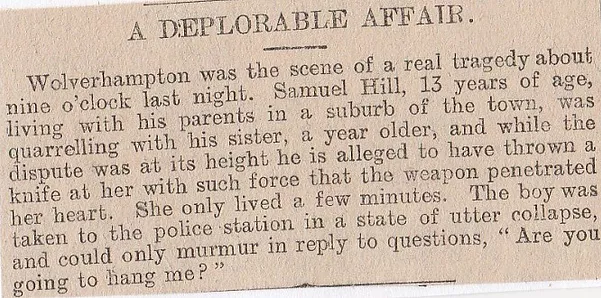
Wolverhampton Tragedy, February 24th, 1899
The 13-year-old youth, Samuel Smith, who killed his sister on the previous night by throwing a knife which penetrated her heart, was placed in the dock on the capital charge. The charge was reduced to manslaughter. The youthful prisoner’s head just reached the top of the dock rail. He was remanded until tomorrow.
Wolverhampton Tragedy, February 28th, 1899
The inquest on the body of Esther Marshand aged fifteen, who was killed on Wednesday by her little brother throwing a knife at her, resulting in a verdict of homicide by misadventure. The two children quarrelled and the girl hurled a fork at the boy who retaliated by throwing a bread-knife, which penetrated her lung. The jury expressed the opinion that the brother had received great provocation.
Wolverhampton Tragedy, March 1899 (Sorry bits missing)
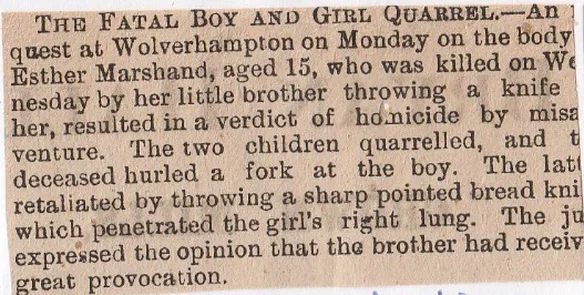
6/ Coventry Suicide, December 1900
7/ Oldbury? August 1889 (Starving a Child)

8/ Birmingham Asylum Murder, December 1858
A religious lunatic at Birmingham Asylum by the name of John Bailsford, killed another inmate at the institution just before Christmas, with the insane object of dipping his hands in the victim’s blood.
9/ Dudley Suicide, May 1899
At Dudley, a man named Aquilla Wallis stood opposite a cemetery (Dudley?) and sliced his throat with a knife, nearly severing his head from his body. Before his suicide, Wallis spent all of his cash.
10/ Birmingham, (Cemetery Suicide), October 1893
Oswald Barber Adams aged forty, the manager of a firm of provision merchants, was seen hanging around the old cemetery for several days. He said he had relatives buried here, then he quietly crept into the chapel basement and took some carbolic acid. He had £40 in cash on his person and when questioned, family and friends said he was given way to mood swings and he was turning into an alcoholic. (What cemetery?/ Is cemetery chapel still there? )
11/ Bournbrook, (Killed at a Football Match) June 1885

12/ Brierley Hill, Dudley, December 1872 (Wedding Error)
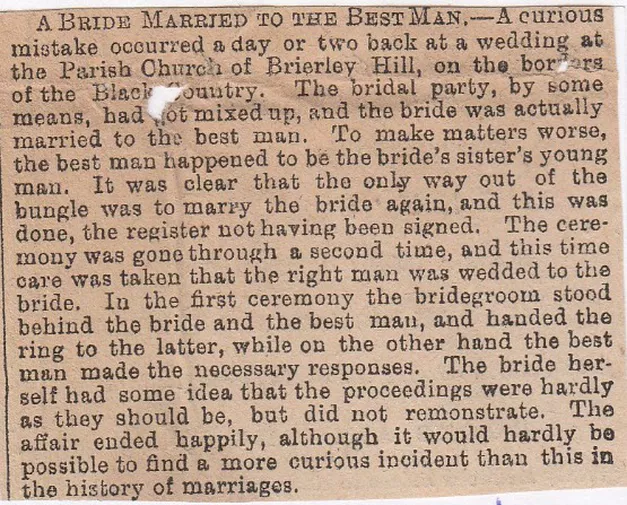
13/ Victoria Park Suicide, Birmingham, July 1897
Charles Bannister, assistant park-keeper at Victoria Park in Birmingham, discovered the dead body of a man hanging from a piece of rope from a tree in the park grounds. It was cut down and sent to Small Heath Mortuary. Police found out that his name was John McDermott aged thirty-nine, a bedstead maker by profession who resided with his missus at 173, Darwin Street. The theory is that he hid in a little-used part of the park and then committed suicide. The body had been there for some time so he must have carried out the deed when the gates were closed for the night. A letter found on his person suggests that the reason for his suicide was down the female of the species, and how he had been wronged by this woman. (His wife?)
14/ Sedgley Ice-Skating Tragedy, January 1885
An inquest at Sedgley respecting the death of James Hyde, stonemason. The deceased was skating with twenty others on New Pool, the previous day, and was precipitated into the water through the breaking of the ice and drowned. A verdict of accidental death was returned.
15/ Princes End Murder, Tipton, June 1859 (In 1859 it was in South Staffs)
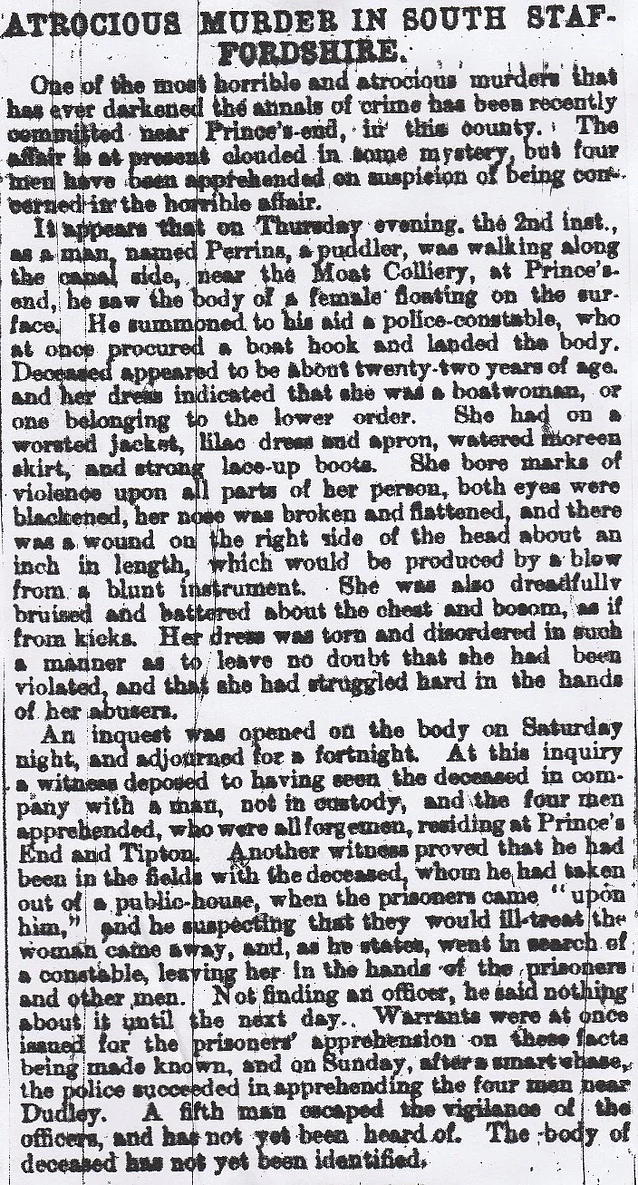
16/ New Street Station, Birmingham, April 1898 (Child Thrown in front of Train)
The 10-15 trundled into New Street Station when William Greaves Edwards picked up his 9-year-old daughter and threw her in front of the train. The London jeweller was arrested straight away and medical attention was given to the child. She lost both arms and one of her legs. He had come to Birmingham to visit the child as she lived there with her Mum, but when asked why he did it, he replied: “I don’t know what made me do it”. The girl is in a dangerous condition and may not survive the ordeal and if she dies, he will be charged with murder and not attempted murder as it stands. (Did she die?)
17/ Birmingham New Street Suicide, October 1875
45-year-old Reuben Roe decided to meet his maker and shoot himself at New Street Railway Station in Birmingham. He had been to his brother’s house with his family, and they pointed out to each other about his strange behaviour. His brother took him out for a stroll at about seven p.m..and they went into the station and while his brother stayed behind for a minute, Rueben shot himself in the chest. A card was found on him, saying: “I have done wrong. God have mercy upon my poor wife and children”.
18/ Bull Ring, Birmingham, June 1889
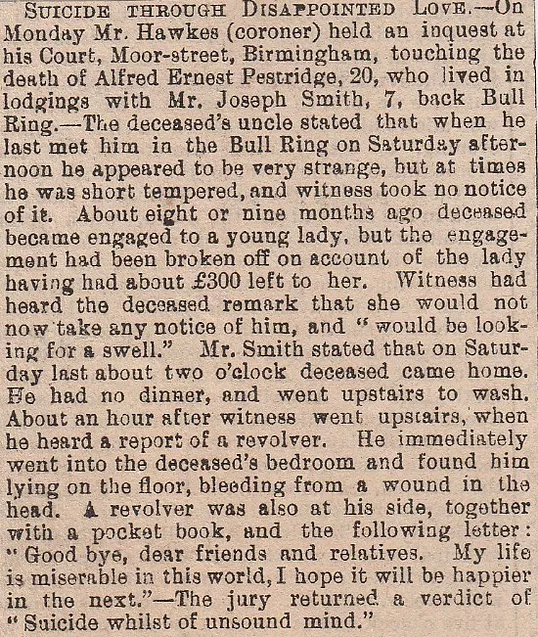
19/ Coventry, (Baker Bakes Himself to Death) December 1899
Frank Morris a master baker from Coventry, decided on suicide, but he only had to utilise what was at his disposal, so he popped himself into one of his ovens in his bakery. Nobody could find him after the dinner break and when one of the lads went to put some water in an oven, he saw his boss’s body in there. He had literally baked himself to death as the door was locked on the inside, and obviously, the body was extremely charred.
20/ Messrs Joyce and Son, Birmingham, October 1907
A labourer by the name of Benjamin Palmer was accidentally caught in the spokes of a fly-wheel of a new engine and was crushed to a pulp, at the works of Messrs Joyce and Son in Sparkbrook, Birmingham, who made steel tubing.
21/ Wolverhampton Child Remains, April 1887
Two labourers at work in an old colliery came across the remains of a human arm which was found sticking out of the ground. They exhumed the rest of the corpse and found it was a young girl, and it was badly decomposed and it’s left arm was missing. Police surgeons examined the body and came to the conclusion that she was no more than a year old when she was killed. Now police are treating this as child murder. (What colliery?)
22/ Christ Church, Birmingham, February 1899

23/ Birmingham Cemetery Suicide, February 1904
Harry Lea, a chemist at Witton, poisoned himself in the city cemetery but left a strange suicide note in the post, sent to his daughter. Firstly, he got her to leave her job, saying that he had £14,000 coming his way, then left this letter:
“When you read this, and see how cruelly I have deceived you, you will say I have deserved the fate of death. Sooner than meet you and Harry, who, God knows, I love too well, I have decided to leave this earth. I cannot face you or Mr Littler, who is a man of honour, and who I have disgraced by my deception. But I have myself been misled. I did think that I had come into some wealth and property until I went over to Ellesmere this week. At the same time, I had no business to have kept such deception up so long. Oh, Maggie, try to forget your father, who has loved you sincerely. May God in Heaven look down on you and preserve you from evil.” – The gravedigger told how Lea prayed in a loud voice and kept kissing a photo, the verdict was not unsurprisingly “Suicide whilst temporarily insane.”
24/ Wednesbury, (Fatal Argument) October 1896
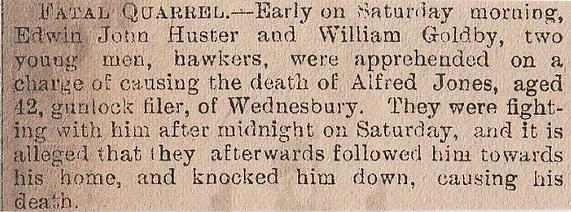
25/ Windmill-End Station Suicide, near Rowley Regis, March 1887
A sixteen-year-old butcher’s assistant named Heaton Pearce was discovered on the train tracks near Windmill-End Station, dead as a dodo. He sent his Mum and Dad the following letter:
“Dear Parents. I write this letter to you under very painful circumstances. I had to leave my place yesterday morning, for using bad language, and I lost my character. I was afraid to come here, so I thought I would write to you and make away with myself because I am ashamed of myself”. The engine-driver said that human flesh and blood was found under the coal-box, and P.C. Salt said that he had been fired from his job in West Bromwich.
26/ Birmingham, May 1901 (Thirty-One Infants Found)
Early one morning police visited a widow who also ran an undertaker’s. They discovered the remains of thirty-one dead infants, all in various stages of decomposition. They were in common or garden soapboxes and should have been interred long ago. They were removed to the Mortuary to await a proper burial and its thought she took the money for burying them, but just kept it and left them there.
27/ Dudley Canal Drownings, August 1890

28/ Walsall, September 1874 (Mob at a Funeral)
Mrs Sadler committed suicide and her funeral was to be on Saturday, but when hundreds of mourners turned up to his house, the White Hart at Caldmore, the gossiping women and the men thinking that she killed herself because of him, they were all baying for blood. The inquest of her suicide was adjourned or incomplete, so the crowd put two and two together and got five. This was mob rule at a funeral and seeing the crowd were after him he decided not to be in the cortege. When he wasn’t seen in the cortege the crowd went looking for him, hoping that there would be “some fun”. The vicar managed to calm things down to some extent and he pleaded with them to abandon the drink. Eventually, she was buried and a wreath placed on the coffin. (What happened afterwards?)
29/ Walsall – 1870 White Hart Inn, Caldmore Green, (See Above)
A mate of mine read about the White Hart in the Readers Digest book of British Myths and Legends, and it reads:-
In 1870 the mummified arm of an infant and a Cromwellian sword were found in the attic of the White Hart at Caldmore Green. The arm, thought to be a relic of witchcraft, became known, incorrectly, as the “Hand of Glory”. Both the arm and the sword became associated with the ghost of a girl who killed herself in the inn about a century before. The landlord has reported strange happenings at the inn, in the last twenty years. A handprint would appear in the dust on a table in the attic, though impossible for anyone to get up there, while the manager spoke of phantom footsteps bumping across the attic floor.
30/ Canal Co.Reservoir, Titford, July 1889

31/ Tividale Murder, July 1902
Two men named Shakespeare and Richards were on their home when they stumbled upon the blood-soaked body of a woman, her head was nearly severed from her body. Just a few yards away they spotted a man with blood on his hands. When they asked him his name he replied “William Lane”, and told them he was an ex-policeman and had slit her throat with a shoemaker’s knife. They took him to police at Rowley and he was charged with the wilful murder of Elizabeth Doson, a woman who he co-habited with. He told police “I have killed her, and have contemplated it for some time”.
32/ Dudley, February 1876 (Romantic Suicide)
Frederick Hooker was a chemist from Kingswinford near Dudley, and he killed himself through grief from the loss of his wife. She died on a Sunday, and when he went to see the sexton about the grave he specified that he wanted one big enough for two people. Hooker then went home and poisoned himself with prussic acid. (What cemetery is Hooker in?)
33/ Darlaston Drowning, June 1899
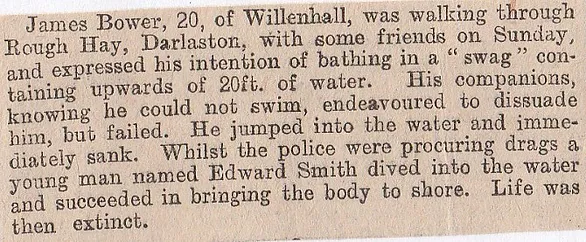
34/ Wolverhampton Incest, June 1878
Nuneaton labourer, Thomas Harbour, was charged with having sex with his wife’s illegitimate daughter who was aged just fifteen, and even more weird was that she stated that she had had sex with four other blokes, one of them was her natural father!
35/ Wednesfield (Wolverhampton), February 1874
An inquest on the body of Lemontinia Smith, who was found dead in a gipsy camp, was resumed at the Summerhouse Inn in Wood Hayes. Evidence was put forward that the man with whom she cohabited, a man named Lovell, used to beat her up on a regular basis. She committed suicide by taking strychnine and had done it to escape the treatment that Lovell would dish out. She also had a lot of vermin powder in her possession.
36/ Birmingham Suicide, October 1897
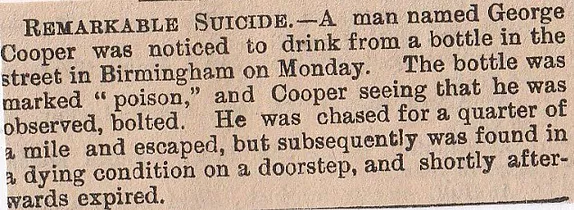
37/ Birmingham Canal, Wolverhampton, November 1899 (Infanticide/Suicide)
The body of Catherine Phillips aged thirty-three and also that of her infant child were found in the Birmingham Canal at Wolverhampton. She went out on Sunday night saying she was off to see her mother and she was taking the little one with her. A couple of days later their bodies were found. Phillips had been suffering from terrible migraines and headaches recently, whether that was the cause is unknown.
38/ Berkeswell Rectory Skeleton, February 1866
Some workmen were taking up a hearthstone in the servant’s hall at Berkeswell Rectory when they uncovered a human skeleton. It was full sized and laid face side downwards with its arms behind its back. They were about four feet from the fire-grate and had other skull fragments were nearby. The bones were decayed and as soon as they came into contact with the air and daylight, most of them crumbled to dust. (Who or what were they?)
39/ Tipton, (Corpse Discovered) April 1896
After a gas leak at the Park Lane Wesleyan School in Tipton, two workmen crawled between the ceiling and the roof and found the lifeless corpse of William Sheldon. He was a caretaker at the Wesleyan Chapel which was next to it and had vanished about three months ago. It was terribly decomposed and it is believed that he killed himself, but in what way he carried it out is unsure.
40/ Tipton, March 1892 (Victorian Football Hooliganism)
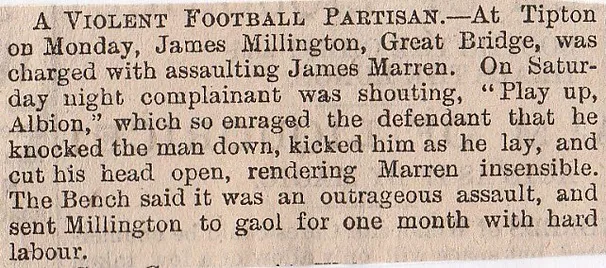
41/ Moxley/Wednesbury, January 1885 (Ice-skating Fatalities)
Two girls named Henry and Hanson were skating yesterday on a sheet of ice between Moxley and Wednesbury when the ice cracked, and before they could escape, they fell into the water, ten feet deep. Their bodies were not discovered until about an hour afterwards.
42/ Darlaston, January 1885
Two girls named Lydia Owen and Martha Wetton, each sixteen-years-of-age, residing at Darlaston and employed at a factory in the neighbourhood, went on Wednesday night to skate. Whilst they were moving about hand in hand together, the ice gave way and both girls were drowned.
43/ West Bromwich, January 1885
David and Archibald Hill, aged six and nine years respectively, were drowned yesterday while sliding on a pond at West Bromwich.
44/ Foleshill Tram Fatality, April 1885
Henry Gilbert, seventy-three years old, was knocked down and killed at Foleshill near Coventry on Wednesday night, by a tram engine running between Bedworth and Coventry.
45/ Spring Vale Ironworks Deaths, Wolverhampton, August 1889
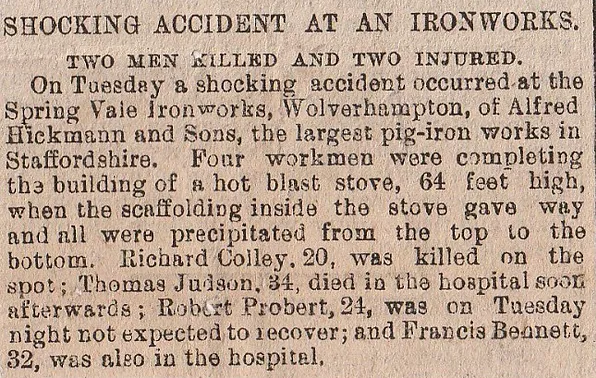
46/ Knowle Hall Double Suicide, (Solihull) May 1865
Mrs Eliza Prentice walked into a police-station at Moor Street and asked them to look for her eighteen-year-old daughter, also called Eliza Prentice, as someone had found a note under a stone and given it to her as it had her name and address on it. It was left on the road leading to Knowle Hall where she worked, along with another girl named Mary Ann Phillips. They seem to have had a disagreement with their mistress and were not to be found at Knowle Hall the next morning. The letter read as follows:-
“We have gone into the water, goodbye. We shall never see you any more. You will see the grave where I die, you will find them now see the grave where I die. You do find them now my life is past. My love to you so long I did last though I know you took his body and loved him for my sake, dated the 2nd of May. The misses called for all the devils and rogues out of the room. She is a bad one, but she has no cause for it. Goodnight. God Bless you dear Edward and to John, and the Devil take the rest for these are the only two we love. We are in the Springfield pools, we will swim to the middle of the pool and there we will stay, and I hope the Misses Moore lies she will go to the Devil in Hell. MARY ANN PHILLIPS and ELIZA PRENTICE”. She thought that the two had drowned themselves but the police told her to go the local police station and they would make a search.
Knowle Hall- Kenilworth Road/Springfield Pools (Springfield Farm on Cuttlepool Lane?) (Did they find them?)
47/ Tipton, (Fatal Accident) August 1885
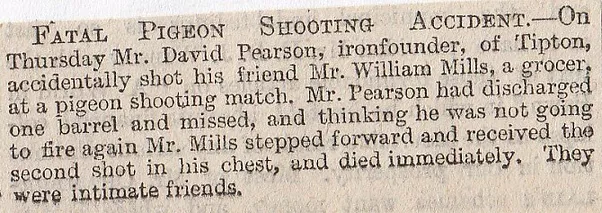
48/ Great Hampton Row, Birmingham, September 1868 (Human Remains)
Some council workmen were digging a new sewer at Great Hampton Row when they came upon the remains of a human in a coffin. It was several feet down and the following explanation is the probable one. A few days before the digging up of the coffin an old man told workmen while passing, that they were not to be surprised if they came across a coffin with a body in it as half a century ago, a man who hanged himself was buried at the crossroads which were there and was known locally as “Hangman’s Lane”. Another scenario was that sixty odd years ago, a bloke murdered his missus in Weaman Street in “Cut-throat Passage” and that when he was hanged for the murder, then he was buried at the place known as “The Four Crossings”.
49/ West Bromwich, (Child Murder/Suicide) September 1882
Thomas Jutson was walking past the Birmingham Canal at West Bromwich at 6-20 a.m. one morning when he spotted the body of a 15-month-old girl floating in it. He got the police to intervene and they searched the canal. About an hour and a half later a woman’s body was discovered about a hundred yards from the baby. She was approximately twenty-five to thirty years old, five feet two inches, light hair, black dress and a white apron on. She also had a gold wedding ring on and the kiddie was dressed in a black velvet coat and cape. They’d been there a few hours at most.(Who were they?)
50/ Dudley, July 1895 (Cricket Death)
Samuel Bunn a licensed victualler, died at Dudley on Saturday from the effects of injuries received through being struck by a cricket ball on July the 8th, while watching the match.
Waterloo Street Suicide, Birmingham, March 1895

51/ Bilston Infanticide, August 1885
At Bilston yesterday, Sarah Betsy Hill a single woman aged eighteen was charged with the wilful murder of her newly-born illegitimate child. The child was found at the back of the house where the prisoner lived, and medical evidence showed that it had died from suffocation. The prisoner said its death was accidental. She was committed for trial.
52/ Coventry Canal Suicide, August 1877
The dead body of James Craney was found standing up in the canal near to the cotton factory at Coventry. When he was fished out it was found that his hands and feet were tied together, while the head was cut. Neighbours had noticed his behaviour had got a little strange recently and occasionally he wandered about for an entire night.
53/ The Council House Fatality, Birmingham, November 1885
As His Royal Highness was about to leave the Council House, Mr R.D.Bennett, of Edgbaston, J.P., director of the Birmingham Joint Stock Bank, met with a fatal accident by falling through a sheet of glass in the floor on the floor of the corridor onto the pavement fifty feet below. He was killed on the spot and was fifty-seven years of age.
54/ Wolverhampton, March 1890

55/ King’s Norton, Birmingham, March 1892 (Teacher Suicide)
The body of Amy Bakewell, a twenty-year-old teacher who worked for the Birmingham School Board, was discovered in the reservoir at King’s Norton near Birmingham. It is being treated as a suicide. It is the second such case of a lady teacher killing herself in the past week, as another young lady teacher committed suicide in a pool in one of the public parks in the city. She also was employed by the Birmingham School Board.
56/ Wolverhampton Child Murder, June 1885
At Wolverhampton yesterday a coroner’s jury resumed an inquiry as to the death of Edith Jones only four years of age, who was last week found drowned in the canal with her mother, Ann Jones, being at the same time found in the water in an exhausted condition. The woman died on Sunday. The jury returned a verdict of wilful murder against her.
57/ Workhouse Lane, Tipton, September 1885 (Burned to Death)
An old woman named Sarah Cole was found burned to death in a house in Workhouse Lane, Tipton, yesterday. The old woman was dropsical and being unable to get upstairs, a bed was made for her in the kitchen. Yesterday morning she was found dead, her body presenting a shocking appearance. The bed was also destroyed. It is supposed that the bed clothing became ignited by the kitchen fire.
58/ Birmingham, July 1889 (Held Head in Molten Metal)

59/ Dudley, February 1878 (Castle Mill)
The half consumed body of an unknown man was discovered in a lime-kiln at Castle Mill, the property of the Earl of Dudley. The face showed signs of suffocation and when moved the legs dropped off the body. Apparently, he is a local man, but that just guesswork at the moment. (Who was he?)
60/ Smethwick, (Body at House-viewing) February 1895
One afternoon in Smethwick, a couple were looking over a house when they came across a dead body of a man in one of the rooms. He was about forty-ish, five feet five tall, brown hair, sandy moustache, and had a tooth missing. The house had been unoccupied for some time and it is presumed that he took shelter from the weather and was frozen to death. Police do not suspect foul play, put it down to natural causes.
61/ Birmingham Constable Murder, March 1898
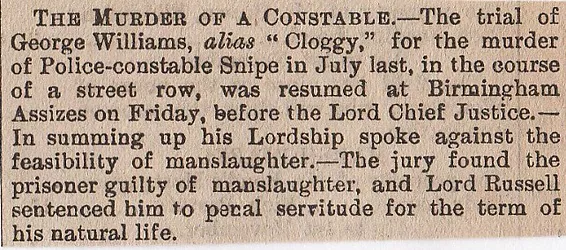
The twenty-year-old Williams threw a brick a the officer and killed him accidentally.
62/ Walsall Railway Station Death, October 1885
Yesterday morning Mr William Thomas, formerly a solicitor in practice in Walsall and at one time the mayor of that borough, was walking over a level-crossing at the Walsall Railway Station when he was knocked down by a train that was entering the station and was killed instantly.
63/ Birmingham Pub Manslaughter, October 1885
A young man named Marney was remanded yesterday at Birmingham charged with causing the death of Thomas McGuire. The men quarrelled in a public-house on the previous night and Marney threw a glass which struck him in the neck, cutting the jugular vein and causing him to bleed to death. (What pub was it?)
64/ Coventry, (Frightened to Death) July 1889
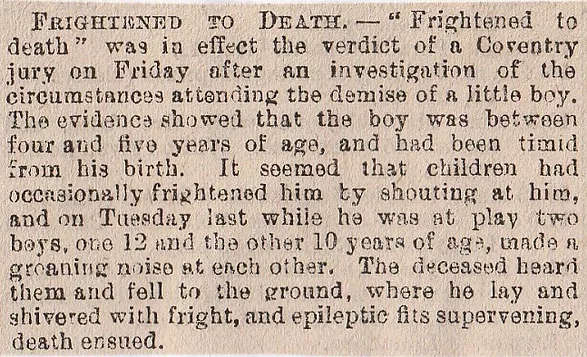
65/ Oldbury Suicide Pact, July 1889
21-year-old Joseph Harvey, who was a brickyard labourer and lived at 2, Titford Road, Oldbury, along with Elizabeth Bates aged twenty, living at 56, Eel Street, Oldbury, have been found dead in the canal near Titford Pool, with all the signs suggest it was some kind of suicide pact between the two. Enoch Hadley was walking along the canal side when he spotted a couple of hats laid near the edge. He contacted police, and when they dragged the canal they found the two of them tied together with a cord. It went around the bodies several times and the knot position seems to point to the girl had tied it. Harvey’s watch had stopped at 2-20 and despite seeing each other for three years, his Dad objected to them being a couple. A letter was found saying that they did this on purpose and because of family grievance’s they wanted to go together.
66/ Gibbet Wood Suicide, Stourbridge, October 1882
The body of an old woman was discovered in Gibbet Wood, a couple of miles from Stourbridge. Three men, David Fletcher, Edwin Highway and Frederick Bent, found the remains while going through the woods. Her undergarment was pulled over her chest and her hat and skirt were a few yards away, but despite this, there were no signs of a struggle. Deceased had three rings on her left hand and a shilling next to her, She has laid in the woods for about a week.
67/ Bilston, Wolverhampton, July 1885
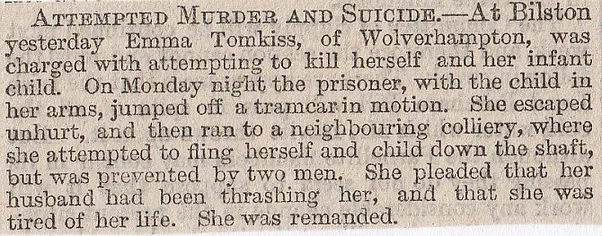
68/ Commercial Street, Birmingham, September 1892 (Head Squashed in Press)
A press-worker named George Sutton aged thirty-five killed himself in a horrible manner at Messrs Wynn, steel stampers in Commercial Street. Some workmen who were about to start work on a Saturday morning found Sutton, who had stayed behind from the previous night. He had put his head under one of the presses, which weigh about four hundredweight, released the hammer which descends at about one ton of pressure and let the machine squash his skull to smithereens. He had taken to drink recently as his he had only become a part-time employee at the works.
69/ Aston Train Death, Birmingham, September 1892
Some lads were playing in Aston New Town when a train came in to view. They all got out of the way except eight-year-old Alfred Faulkes, who was struck with fear and became the proverbial rabbit in the headlights and the train ploughed into the poor lad, decapitating him and badly mangling his frail body.
70/ Birmingham Manslaughter, April 1892
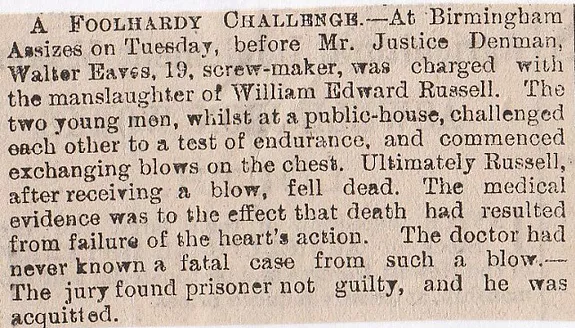
71/ Coventry, (Suicide in front of Wife) December 1887
This is a f****d up way to end your days! George Moss, a watch finisher aged thirty-nine, called his missus into his workshop in Hood Street and announced to her that he wanted to die. She passed it off as him feeling sorry for himself and told him not to talk like that. With those words, he pulled out a revolver and put it to his forehead and blew his head off. His wife is in severe shock and has managed to tell police that Moss had been ill for quite a while, but never showed suicidal tendencies.
72/ Tyburn, Birmingham, March 1887 (Decapitated Baby)
At Tyburn, three miles from Birmingham, a boat was chugging along the canal, when it struck a large parcel. They pulled it to the surface and discovered it was the remains of a three-month-old child. Its head and limbs had been chopped off and the doctor who did the post-mortem on the trunk of the baby said it had been cut to bits with a sharp knife, possibly a scalpel. Police are dragging the rest of the canal to try and find the limbs or head.
73/ Bordesley, (Man Buried Alive) August 1892
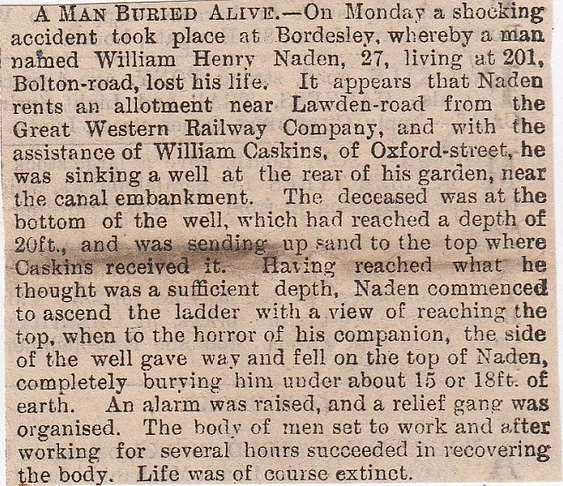
74/ Halesowen, (Child Burns to Death) July 1897
Thomas Ray aged thirteen was found deceased in horrific circumstances. At eight p.m. Saturday he was sent out on an errand but wasn’t found again till a search party discovered his smouldering remains on a heap of coal dust near the ovens at Witley Pits, Halesowen. The limbs were burned off and the rest of him was burnt to a cinder. A post-mortem found his intestines were completely destroyed and his bones were calcined. On asked to identify the body of his son, the father only made him out due to a small patch of hair on the top of the head which resembled his son’s. How he got there is a mystery, but it could be that he laid down on the ashes for warmth, then noxious gases made him unconscious and then he was slowly burnt to death. A case similar to this happened to a tramp who slept near a lime-kiln and had his feet burned off, and did not realise until he got up to leave.
75/ Queen’s Hotel Suicide, Wolverhampton March 1885
A young woman was found dead in her bedroom at the Queen’s Hotel in Wolverhampton and it is feared that it was an act of self-destruction. When the body was being removed, a laudanum bottle fell on to the floor. She has been identified as Adelaide Perks, a servant who was fired from her job on Monday.
76/ Birmingham Canal Suicide, Halesowen, December 1885
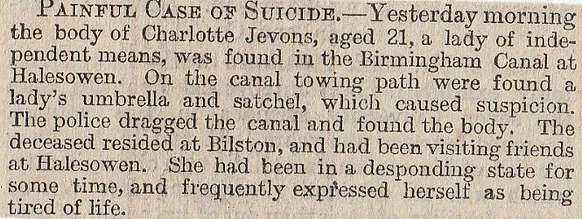
77/ Wolverhampton Murder, December 1902
A woman’s body was found on the tow-path on the canal at Wolverhampton and judging by the looks of the corpse, she had been kicked and battered to death. She was raped first, then beaten and left face down in the mud. She wasn’t smartly dressed, so chances are she was from the lower classes. Another strange thing was that she had her legs tied together.
—A few days afterwards she was identified as Jane Daley, a thirty-year-old housewife.
78/ Arthur Street, Birmingham, June 1899 (Child Corpses in Cellar)
A foul smell was emanating from the cellar at a house in Arthur Street in Birmingham. When found, it was discovered it was the rotting remains of nine children, with each one in a soapbox carefully enveloped in padding. The woman who used to reside there, named Bowen, is now in a critical condition at the Workhouse Infirmary and hardly any information can be gleaned from her. Mrs Bowen was a midwife to the poor people of the area and her two sons said they never ventured into the cellar until Monday night when the bodies were found. Bowen left the house a week or two ago.
79/ Birmingham Canal Suicide, Wolverhampton, December 1885
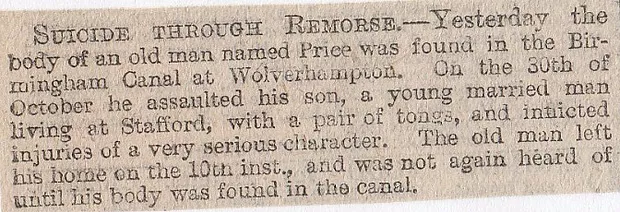
80/ Brierley Hill, June 1900 (Death by Dynamite)
John Jackson, the publican at the Brockmoor House in Brierley Hill, killed himself in an extraordinary manner. A loud explosion was heard in the top half of the house, with a window in one the rooms shattering and on inspection, it was found like a scene from a horror movie. Jackson had put some dynamite in his shirt and lit the fuse and the result was that tiny little portions of flesh and his innards covered in blood, were on the ceiling and walls. Jackson had some financial difficulties and the fact that some mining operations had caused his house to become unsafe; he had forty poles holding it together.
81/ Church Lane, Aston, August 1904 (Child Remains)
An awful discovery was made at 190, Church Lane, Aston, when D.I.Jackson and D.S. Whitcroft went to check the rancid odour coming from the back of the premises. In a rainwater cistern, they found the carcass of a female child, which had supposedly had been put there eleven months ago. Despite the terrible condition of the body, they narrowed it down and later arrested Eleanor Baker, a married woman who had been separated from her husband.
83/ Birmingham Attempted Murder, February 1895

84/ Rowley Regis, Dudley, April 1859 (Tree Falls on Boy)
Twelve-year-old Thomas Baker met with a terrible accident at the premises of Mr Lees, a farmer from Cogg Green in Rowley Regis. Some men were chopping down trees when they nearly cut through one tree, they left it to get some rope to tie around it and pull it over in a particular direction. While they were gone, young Baker, who had been watching them while leaning against a wall, when suddenly the tree collapsed and smashed the poor boy to atoms.
85/ Spedwell Road Suicide, Edgbaston, October 1856
This a sorry story of a young domestic servant named Elizabeth Barton who was employed by Charles Smith at Spedwell Road in Edgbaston, who killed herself by drowning in a water cistern at the back of the house. She became distressed when she heard that her ex-boyfriend, with whom she had a child, had got married to someone else. Barton had been seeing him for six years, then he left and then returned to take the child of theirs to London. All these things accumulated as pressure on her mind, so she ended it all by drowning.
86/ Wolverhampton Skeletons, May 1881
Under the flooring of a cellar in Wolverhampton, the remains of an elderly man and a young person were discovered. The man’s skull was fractured and the younger skeletons skull had been cut down the middle. Both were buried in lime and neither skeleton was complete. The house was being cleared as part of a condemned area and used to be a marine store dealers, but both remain unidentified as of now. (Were they Identified?)
87/ Sugar Loaf Farm Shooting, Stourbridge, October 1885
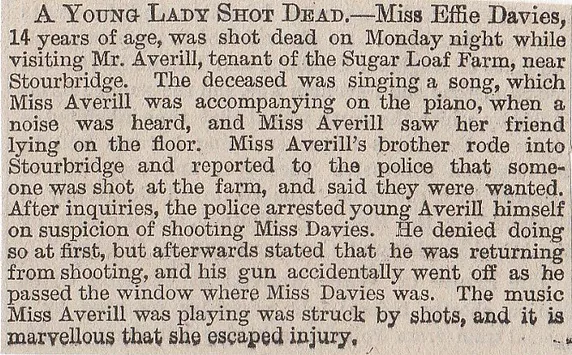
88/ Kings Norton, June 1897 (Suicide Writes own Epitaph)
A chap named Frederick Barton was wandering through a field at Broveley near Kings Norton, when he noticed a man sat upright and apparently asleep. When he got to the body, the head was nearly severed from the neck and his right hand had a razor in it. Police were called to the scene and the body was of a man aged 35, light tanned jacket, dark trousers, black hat, silk umbrella and a silver watch on a brass chain. He was about five feet seven inches tall, brown hair brown sideburns and moustache. In his pockets was a fiver plus other change and oddments and a notebook with the following epitaph:-
Here lies the body of W.W., Who no longer will trouble you, trouble you, Where he has gone, and how he fares, Nobody knows and nobody cares. Signed-Walcot.”
89/ Birmingham Teenage Suicide, April 1891
George Herbert Monk was a fifteen-year-old suicide victim. No wonder, when his mother pawned his best overcoat for cash and then his best clothes went to them as well; he got so distressed by it all, he hung himself in his bedroom. On the day of his destruction, he gave his younger brother a ball as a keepsake of him and told him he’d be out of his misery soon. Next to the body was an open Bible.
90/ Wolverhampton, May 1876 (Skeletal Remains of Kids)
One evening a man named Carey had a row with his missus and when police intervened, she demanded that he be arrested. She got down from a shelf, a parcel with bloodstains on it, and when opened it was found to contain the skulls and leg bones of two children. The post-mortem revealed that one frontal bone (forehead section of the skull) was fractured. Mrs Carey stated that she had sixteen kids and she can account for nine at the time of writing.
91/ Rowley Regis Station Fatality, December 1885
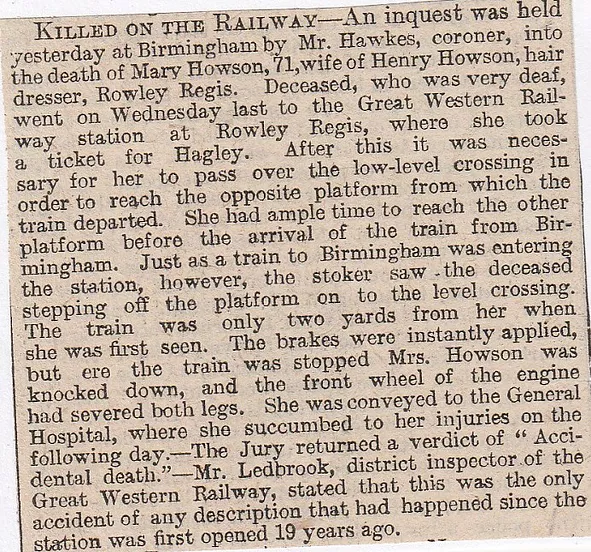
92/ West Bromwich Bride Suicide, June 1888
A twenty-year-old lass named Phillips killed herself at West Bromwich. She had been seeing a chap named Scott for around three months and they were to be wed this week. Tragically she was stood at the altar for over two hours and he never showed. He had suddenly got cold feet and totally disappeared from the town. She went home “heartbroken” and poisoned herself with laudanum and died that night.
93/ Dudley Road, Birmingham, September 1898
Police went to a house on Dudley Road to arrest William Woodhead on a charge of stealing coffin furniture. An awful stench forced police to search the premises and the result was the dead bodies of six children. Woodhead had been given the bodies to be buried and taken the money but left them to decompose.
94/ Birmingham Canal (Filicide/Suicide), Wolverhampton, September 1909
The tiny body of a baby girl was discovered in the Birmingham Canal, dressed in her night clothes. She was identified as fourteen-month-old May Screen, an iron-workers daughter from Bradley near Wolverhampton. Further dragging of the canal brought the mother to the surface. She had left home in the night and picked her daughter from her cot and walked to the canal, then jumped in, killing them both.
95/ Birmingham Murder, February 27th, 1885
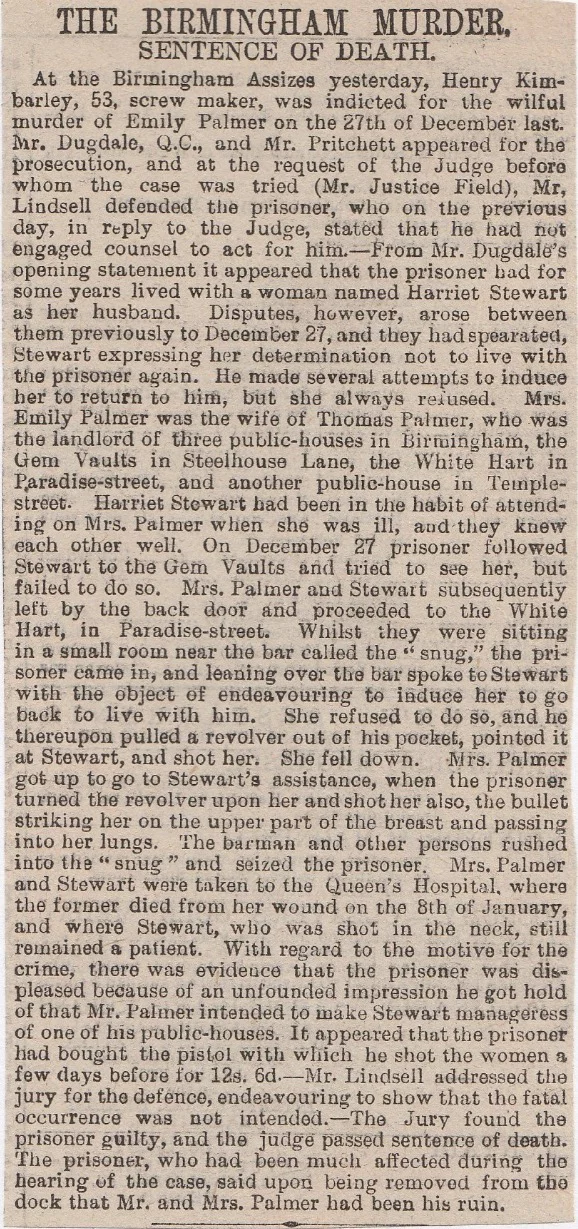
Birmingham Murder, March 18th, 1885
At Winson Green Prison yesterday morning, Henry Kimberley was hanged for the murder of Mrs Palmer in Birmingham last December. Berry was the executioner and did his work most expeditiously.
96/ Park Lane Triple Murder, Aston, Birmingham, December 1910
A triple tragedy took place at the home of William Pope, who resided at Park Lane, Aston. A daughter of Pope’s landlord called in for the rent but saw Pope sat in a chair with a huge gash along his throat. Police forced entry and found the man dead. His wife was also lying dead near the hearth and the two kids, a four-year-old girl and a boy of eighteen months, were laid out on the table with their throats cut. Furniture was overturned, ornaments and vases on the floor which suggest there was a great struggle before they met their maker. Rigor-mortis results showed they had been dead for around twelve hours or so, and the kids in their nightclothes, it seems he got them out of bed to kill them. A letter addressed to the coroner said: “Let no man think I am insane”. Also added was a sentence saying that he wanted to kill himself, but couldn’t bear to leave his wife and kids behind. The wife had put up one hell of a fight against her husband and despite the twenty-seven-year-old Pope having a good job and marriage, he wiped out his family in a supreme act of selfishness.
97/ Bilston Witch Hunt, August 1859
A disgusting event took place at Highfields near Bilston. An old lady named Poll Powis lived in a cottage in Spring Vale and she was locally known as the Spring Vale Witch. This is how Matthew Hopkins became the Witchfinder General in 17th century East Anglia, through the locals victimising an old woman of the village who lived alone and no relatives to visit and of slightly eccentric habits. They were deemed to be witches and drowned or hung in public. ( Burned is the popular misconception). Powis was seen near the canal one day when she suddenly leapt into the water from the bridge. She was rescued by some boatmen on the canal, then it states she was “exhibited in a most beastly way”. A gentleman appeared and put a stop to their antics, but poor old Poll died a short while after and when examined, her body was painfully thin and under-nourished. What the men did to her, God only knows.
98/ Dad’s Lane Suicide, Highbury, Kings Heath, December 1897
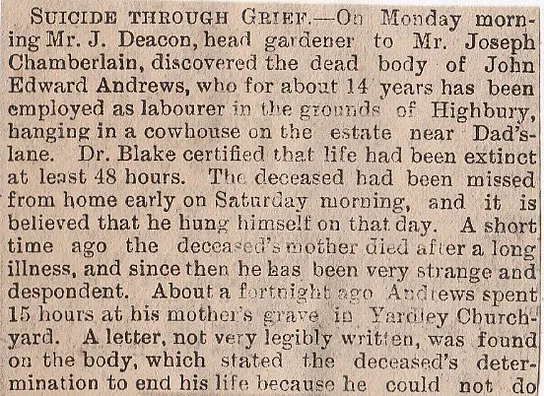
without his mother to whom he was very much attached. The deceased was thirty-eight-years of age.
99/ Snow Hill Station Suicide, December 1908
This one is so common in Victorian England it defies belief. A man was on the platform at Snow Hill Station in Birmingham, when he flung his arms up and jumped in front of an approaching train. The engine and coaches trundled over the body and cut him in half. His sister identified him as William Raymond, a thirty-one-year-old actor from Kidderminster. The sister had gone to ask about the luggage when William went to the other platform and performed his final act. The two of them had been at the Kings Hall in Birmingham rehearsing a pantomime and now she was on her own, as the mother died three months ago.
100/ Snow Hill Station, (Child in Box) January 1896
A square-shaped parcel lay unclaimed at Snow Hill parcel office, so officials contacted police. When unwrapped, it was found to contain the corpse of a newly born baby boy. He was dressed and was put in a little box with a small piece of cloth over his face. Every conceivable effort was made to prevent identification of the child and where he came from. It was addressed to “Miss Jones, Market Square, Birmingham, to be left till called for”. There is no railway mark on it so it was put among the luggage secretly by the mother and then she left the station. It has been dead at least a week or so.
101/ Blews Street, Birmingham, March 1893 (Steam-roller Suicide)
At 4-40 one afternoon, a council steam-roller was on it’s way down Blews Street to the wharf, when a man jumped in front of it and laid down. The driver managed to stop the hulking great mass of metal from going over him entirely but it did partially run over him. It rested on his chest and he was quickly dragged from under the roller and taken to the General Hospital. His injuries were so severe that he died a couple of hours after being brought in. The rib-cage was smashed in and his arm flattened. One witness said he had been walking alongside the steam-roller for quite a distance, checking it out before he dived in front of it.
102/ Lancaster Street, Birmingham, June 1895 (Acrobat Suicide)

103/ Lye Station Suicide, near Stourbridge, July 1871
A shocking suicide occurred at Lye Station near Stourbridge, and there are circumstances with this one which link them with three others of the same family who have died mysteriously in a week or two. Two children were killed at Lye Station in a dreadful accident, then their cousin Arthur Wooldridge, drowned a few days later while taking a dip in the water. Then there was this one. Twenty-two-year-old George Wooldridge, who had been seeing a girl but they had a disagreement in Stourbridge one evening. He got in a cab and asked to go to his father’s house, but stopped the cab near Lye Station and ran towards the tracks. The following day his headless corpse was discovered by the side of the tracks. He appears to have laid down on the line and let the engine run over him. His right leg was also cut off in the act of self-destruction.
104/ No.40 Vauxhall Road, Birmingham, June 1880 (Child Corpses Found)
When a group of bailiffs entered the chemist shop of a fifty-eight-year-old man named Garlick in number 40 Vauxhall Road, they found the bodies of three newly-born children under the counter, each one was in a state of decomposition. He was arrested and later told police that a couple of months ago the kids had been brought to him for burial but he left them because of his ill-health. They were taken to Duke Street Mortuary.
105/ Wolverhampton Shooting Accident, September 1885
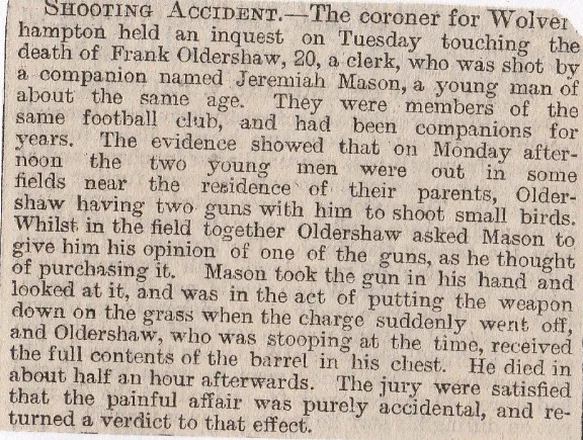
106/ Ladywood Road, Birmingham, August 1872 (Decomposed Body)
A decomposed corpse was discovered in Ladywood Road area of Birmingham. A bloke by the name of Thomas Latham lived in Ivy Cottage at the back of number 207, Ladywood Road. He was semi-retired and used to have his own building business and was comfortably well off. His wife died just over a year ago and they were childless, so he was on his own in his twilight years. Friends popped in to see him but hadn’t come across him for a fortnight or so and they were getting a bit worried. He was going away for a few days, so they thought he’d extended his stay and gone somewhere else for a little break. After a period of a week or two, his nephew got really worried about him, so he went to the house and asked neighbours of his whereabouts. They thought he was inside, so they scanned the building to check if all was well. While up a ladder and looking into his bedroom, an object was seen lying on the bed. Police were involved and they broke in and found him upstairs, on the bed in a dreadful state of putrification. It is thought he died from drinking too much.
107/ Handsworth Murder, April 22nd, 1885
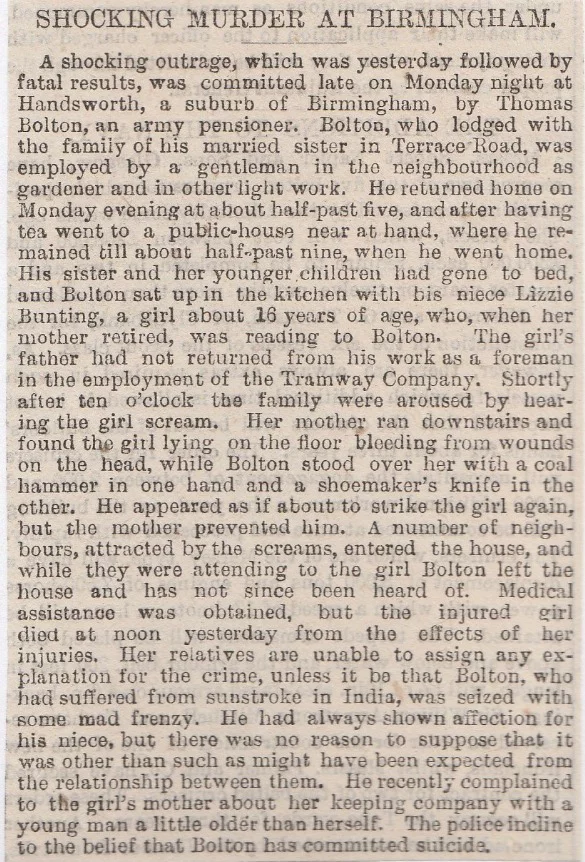
Handsworth Murder, May 2nd, 1885
The murder at Handsworth, Birmingham, by a pensioner named Boulton of his niece, has had a melancholy sequel. The mother of the murdered girl has since become insane. She is continually raving on about the murder and has had to be placed under restraint.
108/ Handsworth Murder, August 1st, 1885
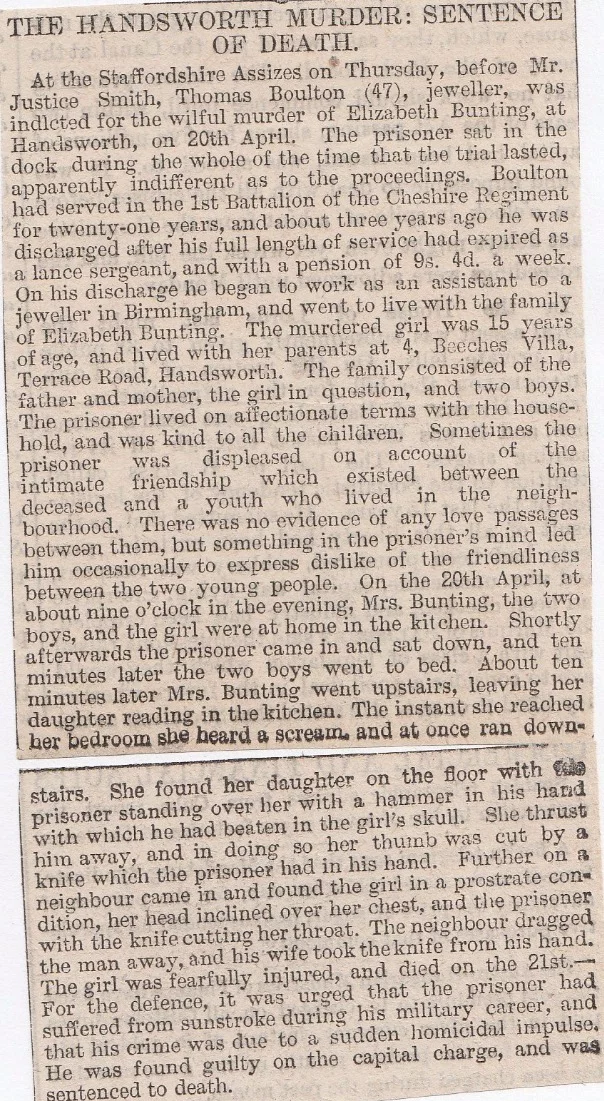
109/ Spread Eagle Inn Deaths, Speed Street, May 1855
An awful accident happened at the Spread Eagle Inn in Speed Street, Birmingham. In the Inn was a concert room which was attended by the poorer members of Birmingham society, when at 9-30 p.m. someone shouted “Fire!”, after a small gas leak had occurred and mass panic ensued. Dozens were clambering to get out, some fell downstairs and others trampled on by people trying to get to the exits and three people died, one of them a policeman. Others went to Hospital and several remain in a critical condition. (How many died?)
110/ Montague Street/Hazeley Street, December 1871 (Human Remains)
Workmen digging a new road between Montague Street and Hazeley Street found three skulls and several other human arm and leg bones. They were all facing the same way and the skulls differ in size from an adult to a slightly smaller one, to the last which is obviously that of a child. The place where they were dug up, is of “new made” ground, which was the earth that was put there by the Ely Company in 1853 or 1854. There is no record of a burial site being there or cemetery, but the coffin handles were left near the bodies, so they were given a decent burial. (Who were they ?)
111/ Navigation Street, Birmingham, March 1877 (Murder/Suicide in Brothel)
This chap comes from a town near where I live, so holds more interest than most for me. His name was John Nicholson from Louth in Lincolnshire (lovely little town, like stepping back in time!), and he was lodging with a young lass called Minnie Fantham who was the wife of an innkeeper. Anyway, Minnie started to show an interest in other blokes in the house and he became viciously jealous. She had a concert trip with two other blokes planned and Nicholson was having none of it. He asked to see her in his room at four o’clock and she went up to see him. Nobody heard anything from her till 8-30 p.m. when the landlady found her on the floor with a huge gash in her throat. He was sat in a chair with his throat also slit from ear to ear. He died in hospital just five minutes after being admitted.
112/ Wednesbury Fatal Accident, January 1885
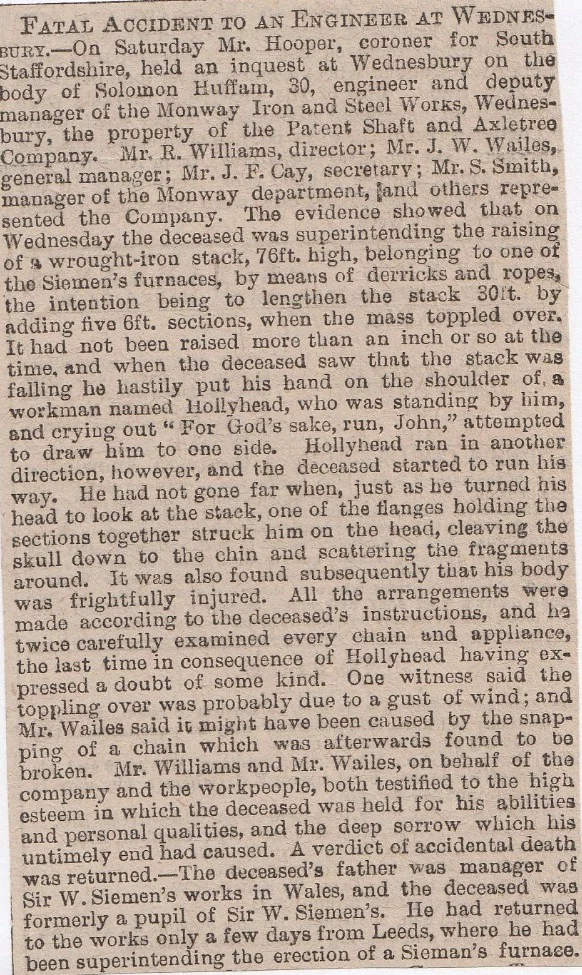
113/ Birmingham Suicides, May 1893
John Redman a fifty-year-old actor, and at present on tour in Birmingham, killed himself at his lodgings. His fellow lodgers were off on a day-trip. He opted out instead, going up to his room supposedly to have a shave and then off to bed again. He was found with a slashed throat several hours later on. His wife had died a few years ago and he missed her dreadfully, so he took his own life. Apparently, he was a superb singer and a very good actor and was highly thought of by fellow professionals.
On the same day as Redman’s suicide, another took place not a million miles away. It was a servant girl, Ethel Millard, who was accused of improper conduct by her mistress and when told of this she flew into a rage and swallowed some rat poison, dying soon after in great agony.
114/ Sherlock Street Skeleton, Birmingham, October 1889
The skeleton of an infant was found up a chimney at 140, Sherlock Street in Birmingham. John Jackson had been living there for three years and the rooms in the top of the house were unoccupied and the chimney bunged up with paper. Miss Jackson was clearing it out when a child’s skeleton dropped down, and when police got in contact with the previous tenant, they denied any knowledge about it. It was believed to have been secreted up there by a servant girl who was employed at the property at some point. It is thought to be that many years ago since the child was put up there. The chance of anyone accounting for the dreadful crime is minimal.
115/ Birmingham Library Suicide, August 1878
Tradesman H.Hill committed suicide in the Birmingham Library by swallowing some poison. His brother said he had been suffering from depression recently and he left a couple of notes to explain his reasons for his suicide:-
“My poor dear Wife- In spite of all your good and noble efforts to drive me from this terrible, mad, mad despondency, I cannot resist it. Good God have mercy on you.”-On the back, he wrote “Look in my desk for letters -H.Hill”. The desk was searched and the following letter was discovered.
“Birmingham 1878- Dear Stone- For the love of all you hold dear, I pray of you to give the enclosed note to Mr W.Wills, Coach and Horses, Bell Street, and of Moseley; do not fail. My poor dear Wife! Protect and guide her for her good as much as you possibly can. Do this for her-the best, truest, and most worthy of wives man ever had. I am mad; have been in a state of suppressed madness on and off ever since I have been out of business, some inexplicable, some irresistible power seems to have been always forcing me to the wrong course since that fatal mistake. Dear old friend, forgive this trouble I put upon you; forget the wretched madman that cannot resist this horrid desire to die. God have mercy on my soul! God guide and protect my poor unfortunate wife-H.Hill”. (Why in the public library?)
116/ Hampton Road, Handsworth, August 1896
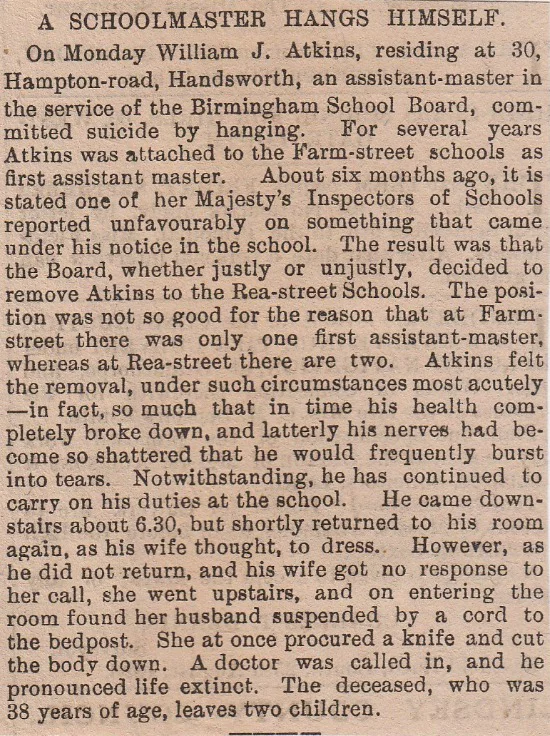
117/ Cambridge Street, Birmingham, August 1898 (Suicide by Circular Saw)
Forty-three-year-old William Davis had a workshop in Cambridge Street in Birmingham. In the workshop was a circular saw and according to the testimony of a lad who worked there, named Diach, Davis simply walked up to the saw and plopped his head in front of it and let the saw do its best against human skin and bone. The lad, who is only twelve and must be traumatised by that sight, told John Kempson what had happened. He rushed across to get Davis from the saw and he managed to a certain extent, but ultimately Davis won the battle and went back for some more of the same. His throat was slashed across and his arm nearly cut in two, as well as a torrent of blood everywhere. Not surprising that he died from injuries sustained.
118/ Minerva Iron & Steel Works, Wolverhampton, May 1875
Samuel Herrard had worked at the Minerva Iron and Steel works in Wolverhampton for fifteen years and had been drinking like a fish over Whitsuntide. One night he woke up, went to the steelworks and threw himself in a water cistern in which the steel is tempered. His son found the body in three feet of water at five a.m. He left a wife and seven kids.
119/ Northbrook Street, Birmingham, March 1898
A young lad named William Pickard was walking along Northbrook Street, which runs parallel to the Birmingham and Wolverhampton Canal, when he spotted what he thought to be a dead pig floating on top. It turned out to be a badly decomposed body of a man with a rope around its neck. When the rope was tugged, it snapped and it sank along with bricks that were attached to it. The body was in a state of putrification, flesh fell off the face and other portions eaten by the water-dwellers. He had a brown tweed suit on, oxford shirt, grey socks, and lace-up boots. As yet he remained unidentified.
120/ Wolverhampton Wife Murder, November 1885
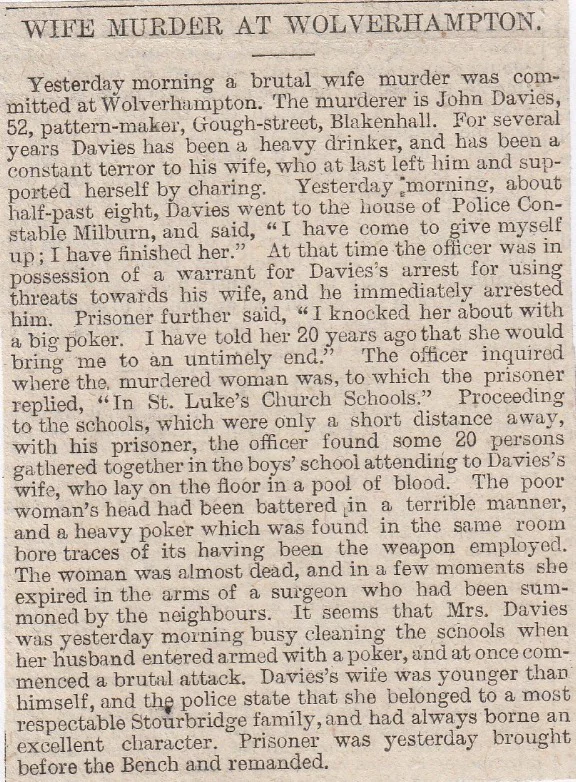
121/ Tame Valley Canal, Perry Barr, June 1887
Marion Lilly Whatton aged eighteen committed suicide at the Tame Valley Canal at Perry Barr in Birmingham.The reason, was that she had been told that her boyfriend was out with another lass. She asked her Mum for some note paper and then she walked out of the door. She was spotted near the canal at Perry Barr, with her hat was found there on Monday morning by a copper walking his beat. The note was pinned to her jacket, also found nearby and it asked that the finder give her mother the note, with her address printed on it. It was short and sweet to say the least, and it said:-
“I leave this note letting you know where I am, I have drowned myself. Give my love to -, goodbye and God bless you.”
122/ Tame Valley Canal Double Suicide, Witton, September 1886
This is quite a romantic story if ever there was one, but it ends in a double suicide of two young girls. Various items of women’s clothing were found on the bank of the Tame Valley Canal at Witton. When the canal was dragged the bodies of two young girls were fished out, both tied together with a silk scarf around their waists. They were Hannah McDonald and Bertha Taylor, both sixteen-years-old who both lived at Aston, and had been missing for two days. A note read:-
“Goodbye, Mrs McDonald forever”. They had both been fired from their jobs at Kynocks and Co’s Ammunition works due to business being slow, but they couldn’t find a job elsewhere. McDonald’s parents had taken care of her, but Taylor was rather skinny and was suffering from lack of nutrition and it’s this that they are thought to have come up with the suicide pact rather than leave one another.
123/ Birmingham Wife Murder, August 1890
At Birmingham Assizes on Wednesday, Frederick Davis a gunsmith of Summer Lane in Birmingham was found guilty of murdering his wife. The prisoner having been reproached by his wife for intemperate habits, shot at her with a gun as she was standing in the kitchen. The bullet pierced her lung and on running into the yard she fell down dead. Justice Hawkins passed the sentence of death upon Davis.
124/ Shirley Shooting Accident, September 1885
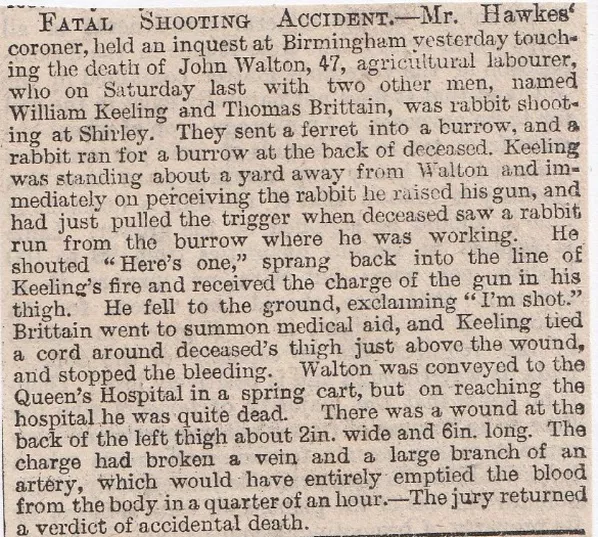
125/ Bilston, (Case of Starvation) June 1887
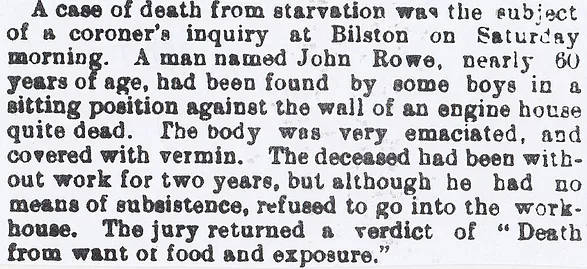
126/ Queens Hotel, (Detective Suicide), Birmingham, April 1883
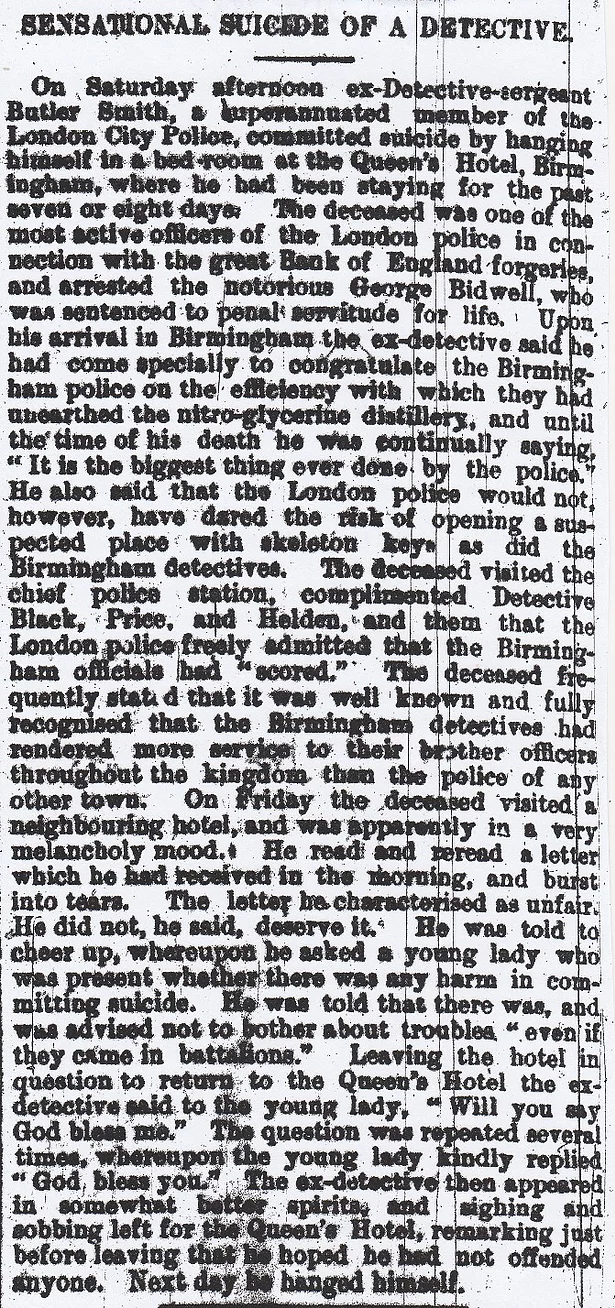
127/ Edgbaston Street Murder, Birmingham. July 1870
128/ Oldswinford Brewing Tragedy, September 1870
A publican named John William Yardley, residing at Oldswinford near Stourbridge, met with a shocking accident on Monday. Brewing was going on, and Yardley stepped on a stool with a bag of malt on his shoulder, intending to empty it into the mash tub. The stool slipped, and he fell backwards into the scalding wort. Though immediately rescued he was so frightfully injured that he died the same evening.
129/ Stourbridge (Strange Story) July 1870

